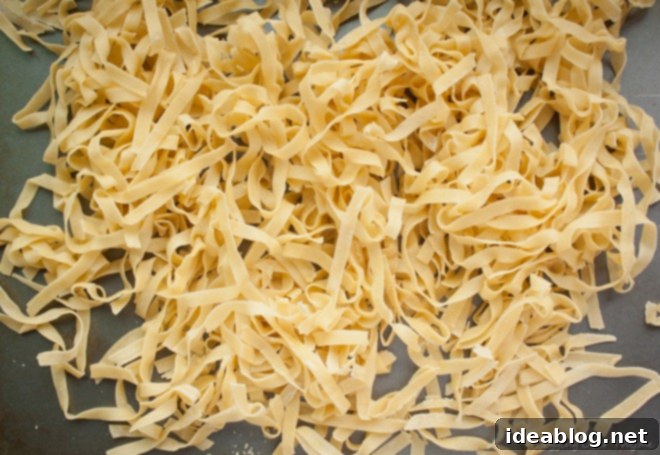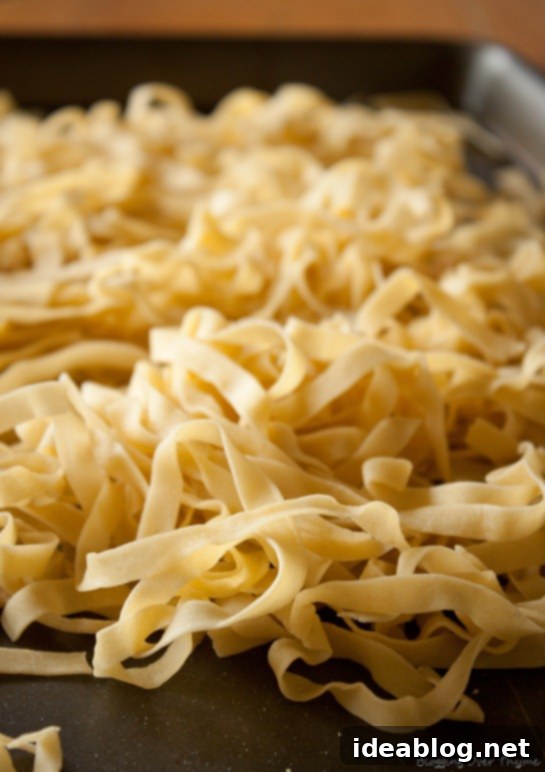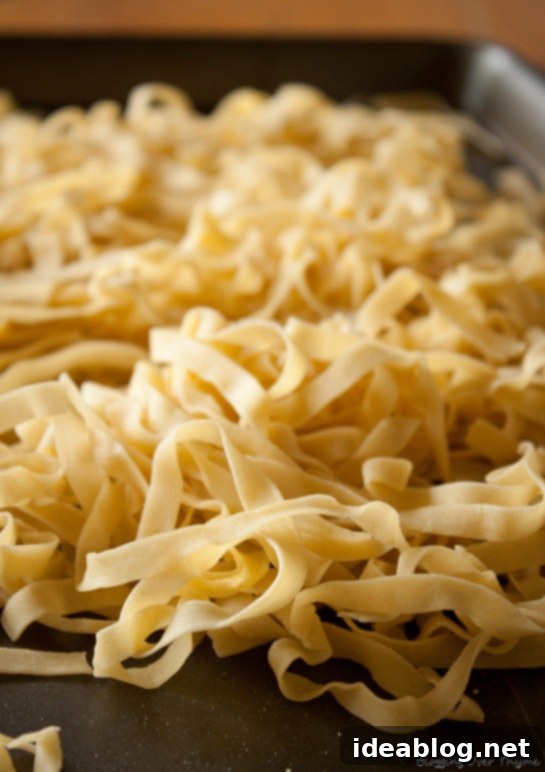Mastering Homemade Pasta: An Easy Guide to Crafting Delicious Noodles from Scratch

There’s a unique magic to homemade pasta that simply cannot be replicated by even the finest store-bought varieties. In my mind, nothing quite compares to its rich flavor, satisfying chew, and incredible versatility. Whether tossed with a simple pat of butter and a generous dusting of Parmigiano-Reggiano, or serving as the foundation for a robust ragu, fresh pasta transforms an ordinary meal into an extraordinary culinary experience. It’s simultaneously comforting and elegant, embodying the heart and soul of Italian cooking at your very own kitchen table.
For many home cooks, the idea of making pasta from scratch might seem like a daunting, time-intensive endeavor, a task reserved for professional chefs or seasoned Italian nonnas. While it’s certainly not an everyday occurrence in my own kitchen, my experience in culinary school revealed a delightful truth: making homemade pasta is far less complicated and time-consuming than commonly assumed. This hands-on process requires only four fundamental ingredients—flour, eggs, salt, and a touch of olive oil—and offers the profound satisfaction of turning basic staples into something truly special and deeply personal.
Of course, this isn’t to say that my pantry won’t still feature my favorite boxed, dried pasta brands like DeCecco and Bionaturae for those busy weeknights when time is short. However, I wholeheartedly encourage you to carve out just 20-30 minutes the next time you find yourself with a little extra time in the kitchen and embark on the journey of making your own pasta from scratch. It’s not just a fun and engaging activity; it’s an incredibly simple and immensely rewarding process that connects you directly to the traditions of Italian cuisine and the joy of creating delicious food with your own hands. The taste alone will convince you it’s worth the effort!
The Pillars of Perfect Pasta Dough: Essential Ingredients
The beauty of homemade pasta lies in its simplicity. With just a few high-quality ingredients, you can create a dough that is both pliable and flavorful. Understanding the role each component plays is key to achieving consistent, delicious results. Paying attention to these basic elements ensures a perfect foundation for any pasta dish you envision.
Choosing Your Flour: “00” vs. All-Purpose
While many traditional Italian recipes call for “00 flour,” a finely milled Italian wheat flour known for its low protein content and incredibly smooth texture, it is by no means mandatory for a successful homemade pasta. “00 flour” contributes to a silky-smooth pasta that cooks quickly and has a delicate bite, often preferred for delicate filled pastas or light sauces. However, if you don’t have it readily available, regular all-purpose flour works remarkably well as a substitute. All-purpose flour yields a slightly chewier, more rustic pasta, which many people prefer for heartier dishes. My culinary school teachings confirmed that either option will result in a fantastic homemade pasta, so don’t let the specific flour type deter you from starting your pasta-making adventure. The key is to find a balance that suits your preference and available resources.
The Role of Eggs and Olive Oil
Eggs are crucial for binding the dough, adding richness, contributing to its vibrant yellow color, and providing essential elasticity. They create a strong gluten structure, which is vital for pasta that holds its shape during cooking and has that desirable al dente bite. For the best results, always use large, fresh eggs. The higher quality of the eggs will directly translate into the flavor and texture of your finished pasta. A small amount of good quality olive oil is often incorporated to further enhance the dough’s pliability and silkiness, making it easier to work with and adding a subtle depth of flavor. It also helps achieve that smooth, velvety texture that is characteristic of excellent fresh pasta.
The Importance of Salt
Often overlooked in dough recipes, salt plays a vital role beyond just seasoning. In pasta dough, it strengthens the gluten network, which contributes to the pasta’s overall texture and prevents it from becoming overly soft or mushy when cooked. Furthermore, it infuses the pasta with flavor from within, ensuring every bite is seasoned perfectly, complementing whatever sauce you choose to pair it with. Without salt in the dough, even heavily salted cooking water can’t fully compensate for the lack of internal seasoning, leaving your pasta tasting flat. A pinch of salt makes all the difference.
Tools of the Trade: Making Pasta Life Easier
While the purest form of pasta making can be done with just your hands and a rolling pin, certain tools can significantly streamline the process and elevate your results. A pasta machine, for instance, is highly recommended for achieving consistent thickness and making the rolling process much more manageable. It’s a worthwhile investment for any enthusiastic home cook.
The Magic of a Pasta Machine (Manual vs. Electric)
A pasta machine, such as the widely praised Imperia brand, is an invaluable tool for consistent thickness and ease of rolling. These machines efficiently flatten your dough into uniform sheets, which is incredibly difficult to achieve by hand, especially if you’re aiming for delicate shapes like fettuccine or linguine. Both manual and electric models are available. Manual machines offer a hands-on, traditional experience, allowing you to feel the dough’s texture and control the speed, and are generally more affordable and durable. Electric machines, on the other hand, provide convenience and speed, perfect for larger batches or for those with hand strength limitations. While not strictly *required*, investing in a good pasta machine will make your pasta-making journey significantly more enjoyable, less strenuous, and yield more consistent, professional-looking results.
Hand-Rolling Techniques: Embracing Tradition
For those who prefer a more rustic approach or don’t have a pasta machine, hand-rolling is absolutely achievable and a time-honored tradition. The key is patience, a sturdy rolling pin (preferably a long, tapered Italian style), and ample space. You’ll need to roll the dough out as thin as possible, turning and flouring it frequently to prevent sticking to your work surface or rolling pin. Once rolled into a large, thin sheet, you can cut the dough into various shapes. A simple and authentic preparation involves cutting the dough into triangles or small squares, often referred to as “handkerchiefs” or “maltagliati” (meaning “badly cut”), which are delightful with chunky sauces as their irregular shapes capture the sauce beautifully.
Crafting Your Dough: From Ingredients to Delicious Noodles
Though every homemade pasta dough recipe might call for a slightly different method or ingredient ratio, the foundational techniques remain consistent. Mastering these steps will empower you to create a perfect dough every time. The following method, which I honed during my time in culinary school, is as fool-proof as you can get, ensuring success even for beginners.
Mixing and Kneading: The Heart of the Process
Begin by forming a neat well with your flour on a clean, spacious work surface. Crack the eggs into the center of the well, add the salt, and drizzle in the olive oil. Using a fork or your fingertips, gradually incorporate the flour from the inner edge of the well into the wet ingredients, working outward until a shaggy, cohesive dough forms. Once the dough has come together, it’s time for the most vital step: kneading. This process develops the gluten, making the pasta elastic and smooth. Knead for 8-10 minutes, pushing the dough away from you with the heel of your hand and folding it back towards you. The dough should become smooth, elastic, and spring back when lightly poked, indicating proper gluten development.
The Crucial Resting Period
After kneading, form your dough into a ball, wrap it tightly in plastic wrap (to prevent it from drying out), and let it rest at room temperature for at least 30 minutes, or up to an hour. This resting period is absolutely critical. It allows the gluten to relax, making the dough much easier to roll out thinly without it snapping back excessively. It also gives the flour ample time to fully hydrate, resulting in a more tender, less brittle, and pliable pasta that is a joy to work with and even more delightful to eat. Do not skip this step!
Rolling and Shaping Your Noodles
Once rested, divide the dough into manageable portions. Lightly flour your work surface and the dough pieces, then begin rolling. If using a pasta machine, start at the widest setting and pass the dough through several times, folding and repeating until it’s smooth and uniform. Then, gradually work your way down to thinner settings, passing the dough through each setting once or twice, until your desired thickness is achieved. For hand-rolling, patience and a strong arm are key to achieving an even, thin sheet. Once you have your thin sheets, it’s time to cut them. You can use the cutting attachments on your pasta machine for classic shapes like spaghetti or fettuccine, or manually cut them into wide ribbons (pappardelle), delicate tagliatelle, or any unique shape you desire. Just be sure to liberally dust your cut pasta with flour to prevent sticking before cooking.

Expert Advice for Superb Results
To ensure your homemade pasta is always a resounding success and to tackle common challenges, keep these additional tips in mind. They are gleaned from years of kitchen experience and are designed to guide you towards pasta perfection.
Battling Stickiness: Flour is Your Friend
Humidity and the exact size of your eggs can greatly affect your dough’s consistency. If your dough feels too sticky and difficult to handle, add a very small amount of flour at a time (half a teaspoon) until it reaches the right consistency – it should be firm but still pliable, not dry. Conversely, if it’s too dry and crumbly to form a cohesive ball, add a few drops of water, kneading it in until smooth. Always dust your work surface, rolling pin, pasta sheets, and freshly cut pasta with a light coating of flour or semolina to prevent sticking, especially crucial when cutting and drying.
Drying and Storing Fresh Pasta
Freshly cut pasta needs to dry slightly before cooking or storing to prevent it from clumping together. You can hang it on a traditional pasta drying rack, lay it loosely on a lightly floured baking sheet, or form small, individual nests. For immediate cooking, 15-30 minutes of drying is usually sufficient to prevent sticking. If storing, fresh pasta can be refrigerated for 1-2 days; ensure it’s well-floured and stored in an airtight container or bag to prevent it from drying out completely. For longer storage, fresh pasta can be frozen for up to a month. Freezing is best done after drying the pasta for a few hours, then transferring it to an airtight container or freezer-safe bag. Cook from frozen, no need to thaw.
Cooking Fresh Pasta: Quick and Delicious
Fresh pasta cooks significantly faster than its dried counterpart, often requiring only a few minutes. Bring a large pot of heavily salted water to a rolling boil – the water should taste like the sea. Add your fresh pasta and cook for just 2-4 minutes, or until it is al dente. This means it should be tender but still have a slight bite. Always taste a piece to check for doneness, as cooking times can vary based on thickness and shape. Its tender texture and rich flavor truly shine with simple, fresh sauces that complement rather than overpower it.
Beyond the Basics: Elevating Your Pasta Creations
While classic egg pasta is delightful on its own, don’t hesitate to experiment with flavor infusions and colors to make something truly unique and impressive. The possibilities are as endless as your imagination.
Herb and Spice Infusions
To go for something a bit more special, consider incorporating fresh herbs like finely chopped rosemary, basil, or parsley directly into the dough during the kneading stage. Dried herbs can also work, but use them sparingly. Cracked black pepper, red pepper flakes, or even a touch of saffron (dissolved in warm water) also add a wonderful aromatic kick, visual appeal, and sophisticated flavor. These additions infuse the pasta with subtle yet distinct flavors, making it a star component perfect for lighter sauces that allow the pasta itself to shine through.
Vegetable Purees for Vibrant Hues
For an adventurous twist and a stunning pop of color, you can substitute a portion of the eggs or water with vegetable purees. Spinach puree (blanched and finely pureed) creates beautiful green pasta, beetroot puree yields a stunning vibrant red, and even roasted red pepper or carrot puree can lend an earthy orange hue. These variations not only enhance the visual appeal of your dish, making for an eye-catching presentation, but also add nuanced flavors and a touch of nutrition. Remember to adjust the flour slightly to account for the moisture content of the purees.
Pairing Your Fresh Pasta: Simple Joys
The beauty of homemade pasta lies in its ability to pair wonderfully with a myriad of sauces, from the simplest to the most complex. Because the pasta itself is so flavorful, often the simplest preparations are the most satisfying. A classic butter and sage sauce, a fresh basil pesto, a light lemon garlic olive oil dressing, or a rustic simple marinara, all allow the inherent goodness and fresh taste of your homemade pasta to shine through. Don’t feel the need to overcomplicate things; sometimes, less truly is more, especially when the main ingredient is this good.
The Rewarding Journey of Homemade Pasta
Embarking on the journey of making homemade pasta is more than just a cooking task; it’s an incredibly fulfilling experience that enriches your culinary skills and deepens your appreciation for food. It offers a tangible connection to your food, a chance to unleash your creativity in the kitchen, and the immense satisfaction of serving a dish crafted with love and care from scratch. The soft hum of the pasta machine, the silky feel of the dough transforming under your hands, the delicate strands emerging ready for the pot – these are the moments that make cooking truly special and memorable. So, take the leap, gather your simple ingredients, and discover the unparalleled joy and deliciousness of fresh homemade pasta. Your taste buds, your family, and your guests will undoubtedly thank you for it.
